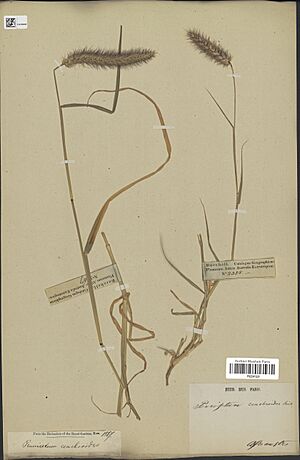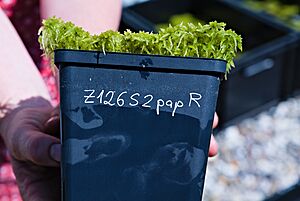Metadata facts for kids
Metadata is simply "data about data." Think of it as a label or a description that tells you important things about another piece of information. It's not the main content itself, like the words in a story or the picture in a photo. Instead, it's the details *about* that story or photo.
There are different kinds of metadata, each with a special job:
- Descriptive metadata helps you find things. It's like the title, author, or keywords that describe a book or a video.
- Structural metadata shows how different parts of something fit together. For example, it can tell you how pages are organized to form chapters in a digital book.
- Administrative metadata helps you manage information. It might tell you when something was created, who made it, or who is allowed to use it.
- Reference metadata gives details about the quality and meaning of facts, especially in statistics.
- Statistical metadata describes how facts were collected or processed, which is important for understanding surveys or reports.
- Legal metadata provides information about who created something, who owns the copyright, and how it can be used legally.
Sometimes, metadata can fit into more than one of these types because it describes different aspects of the same information.
Contents
How Metadata Helps Us
Metadata is super useful for many reasons. It helps people easily find the right information and discover new things. It also helps organize digital files, give them unique digital IDs, and keep them safe for a long time.
Metadata lets you search for information using different details. It helps you find similar things, tell different things apart, and even know where something is located. For example, when you search for a video online, metadata helps the search engine show you the most relevant results.
Metadata has been around for a long time. Libraries used to have card catalogs with cards that held metadata about books. These cards listed the author, title, and subject. In the 1980s, libraries started putting this information into digital databases. Today, with so much information stored digitally, special rules called metadata standards help describe all this digital data.
In 1967, experts David Griffel and Stuart McIntosh first talked about "meta data" for computer systems. They explained it as information describing how data is organized and connected.
Different fields, like museums, music, or websites, have their own unique metadata rules. Describing what's inside a file and its context makes it much more useful. For instance, a web page might have metadata that says what computer language it's written in, what tools were used to create it, and what topics it covers. This helps you find the page online and makes your experience better. A CD might have metadata about the musicians, singers, and songwriters.
Many governments also store metadata about phone calls, emails, web pages, and even cell phone locations. This helps them understand communication patterns.
What Metadata Means
Metadata simply means "data about data." It's information that gives details about other information, making it easier to track and use specific data.
Some examples of what metadata can tell you include:
- How the data was made
- Why the data was created
- The exact time and date it was made
- Who created or wrote the data
- Where on a computer network the data came from
- What rules were followed
- How good the data quality is
- Where the data came from
- The steps used to create the data
For example, a digital image might have metadata about its size, colors, and when it was taken. It can even include details like the camera's shutter speed! A text document's metadata might tell you how long it is, who wrote it, and a short summary.
Web pages also use metadata, often called "Metatags," to describe their content and keywords. These tags used to be very important for web searches. However, people started "keyword stuffing" (adding too many keywords) to trick search engines. So, search engines now use many other factors to rank websites.
Metadata can be stored in a database called a metadata registry. Sometimes, it's hard to tell what metadata is just by looking at it. For example, a list of 13-digit numbers could be anything. But if you know it's a list from a book collection, then those numbers become ISBNs. ISBNs are metadata because they refer to a book without being the book's content.
The term "metadata" was first used in 1968 by Philip Bagley. He used it to mean "data about the containers of data," like how a database is structured. Since then, many fields like information management and libraries have adopted the term, always meaning "data about data."
Kinds of Metadata
Even though metadata is used in many different areas, there are common ways to group its types.
The NISO (National Information Standards Organization) points out three main types:
- Descriptive metadata is used to find and identify things. It includes details like titles, authors, subjects, and keywords.
- Structural metadata explains how parts of an object are organized. For instance, it shows how pages are put together to form chapters in a digital book.
- Administrative metadata helps manage a resource. This includes technical details like the file type or when and how the file was created. There are two special kinds:
* Rights management metadata tells you about who owns the rights to something. * Preservation metadata contains information needed to keep a resource safe and usable for a long time.
Another growing type of metadata is accessibility metadata. This helps describe information in ways that make it easier for everyone to access, especially people with different needs. For example, it could describe if a resource is available in Braille, audio, or large print.
How Metadata is Used
File Metadata
Most common computer files, like documents (e.g., Microsoft Office files, PDFs), images (e.g., JPEGs), videos (e.g., MP4s), and audio files (e.g., MP3s), can have metadata built into them.
Sometimes, you can add metadata to your files yourself. But often, the programs or devices you use to create files (like your camera or a word processor) automatically add metadata without you even doing anything.
While metadata in files is great for finding them later, it can sometimes be a privacy risk if you share files. That's why some people use special metadata removal tools to clean files before sharing them.
Photographs
When you take a digital photo, your camera often adds metadata to the file. This metadata can include who owns the photo, copyright information, the camera model, and even technical details like the shutter speed and how wide the lens was open. You can also add descriptive information like keywords to your photos, which makes them easier to search for on your computer or online.
Many digital cameras automatically record details like the model number and exposure settings. Some cameras even let you edit this information directly. If your device has GPS, it might also record the exact location where the photo was taken. Photographers use keywords and filters based on metadata to organize their photos more easily.
Video
Metadata is super helpful for videos. Computers can't "understand" what's happening in a video, but metadata can provide descriptions of scenes or even transcripts of conversations. This makes it much easier to search for specific content within a video. For example, in security cameras, metadata can save license plate numbers, making it easier to find specific vehicles.
Video metadata comes from two main sources:
- Operational metadata is gathered automatically, like the type of equipment used, the software, the date, and the location where the video was made.
- Human-authored metadata is added by people to help videos show up in search results, attract viewers, and even create advertising opportunities.
Telecommunications
Information about when phone calls were made, who made them, and who received them (but not the actual conversation) is another type of metadata. The same applies to electronic messages and instant messages. This "call detail record" metadata is collected by various organizations to understand communication patterns.
Geospatial Metadata
Geospatial metadata is all about location-based data, like maps, images, and files used in Geographic Information Systems (GIS). It describes details about geographic data, such as who created it, when it was collected, how it was processed, and what formats it's available in. This helps people understand and use location data effectively.
See also
 In Spanish: Metadatos para niños
In Spanish: Metadatos para niños
- AGRIS
- Bibliographic record
- Classification scheme
- Crosswalk (metadata)
- DataONE
- Data dictionary
- Dublin Core
- Folksonomy
- GEOMS – Generic Earth Observation Metadata Standard
- Geospatial metadata
- IPDirector
- ISO/IEC 11179
- Knowledge organization system
- Knowledge tag
- The medium is the message
- Mercury: Metadata Search System
- Meta element
- Metadata Access Point Interface
- Metadata discovery
- Metadata facility for Java
- Metadata from Wikiversity
- Metadata publishing
- Metadata registry
- Metamathematics
- METAFOR
- Microcontent
- Microformat
- Multicam (LSM)
- Observations and Measurements
- Ontology (computer science)
- Official statistics
- Paratext
- Preservation Metadata
- SDMX
- Semantic Web
- SGML
- The Metadata Company
- Universal Data Element Framework
- Vocabulary OneSource
- XSD




